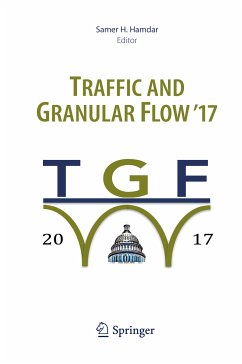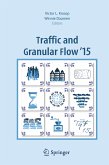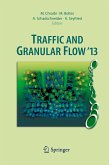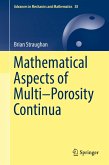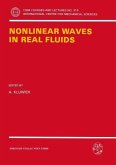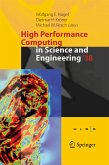Traffic and Granular Flow '17 (eBook, PDF)
Redaktion: Hamdar, Samer H.


Alle Infos zum eBook verschenken

Traffic and Granular Flow '17 (eBook, PDF)
Redaktion: Hamdar, Samer H.
- Format: PDF
- Merkliste
- Auf die Merkliste
- Bewerten Bewerten
- Teilen
- Produkt teilen
- Produkterinnerung
- Produkterinnerung

Hier können Sie sich einloggen

Bitte loggen Sie sich zunächst in Ihr Kundenkonto ein oder registrieren Sie sich bei bücher.de, um das eBook-Abo tolino select nutzen zu können.
This book presents 57 peer-reviewed papers from the 12th Conference on Traffic and Granular Flow (TGF) held in Washington, DC, in July 2017. It offers a unique synthesis of the latest scientific findings made by researchers from different countries, institutions and disciplines. The research fields covered range from physics, computer science and engineering and they may be all grouped under the topic of "Traffic and Granular Flow". The main theme of the Conference was: "From Molecular Interactions to Internet of Things and Smart Cities: The Role of Technology in the Understanding and the Evolution of Particle Dynamics". …mehr
- Geräte: PC
- ohne Kopierschutz
- eBook Hilfe
- Größe: 23.23MB
![Traffic and Granular Flow '15 (eBook, PDF) Traffic and Granular Flow '15 (eBook, PDF)]() Traffic and Granular Flow '15 (eBook, PDF)113,95 €
Traffic and Granular Flow '15 (eBook, PDF)113,95 €![Traffic and Granular Flow '13 (eBook, PDF) Traffic and Granular Flow '13 (eBook, PDF)]() Traffic and Granular Flow '13 (eBook, PDF)113,95 €
Traffic and Granular Flow '13 (eBook, PDF)113,95 €![Convection in Ferro-Nanofluids: Experiments and Theory (eBook, PDF) Convection in Ferro-Nanofluids: Experiments and Theory (eBook, PDF)]() Aleksandra A. BozhkoConvection in Ferro-Nanofluids: Experiments and Theory (eBook, PDF)40,95 €
Aleksandra A. BozhkoConvection in Ferro-Nanofluids: Experiments and Theory (eBook, PDF)40,95 €![Mathematical Aspects of Multi-Porosity Continua (eBook, PDF) Mathematical Aspects of Multi-Porosity Continua (eBook, PDF)]() Brian StraughanMathematical Aspects of Multi-Porosity Continua (eBook, PDF)46,95 €
Brian StraughanMathematical Aspects of Multi-Porosity Continua (eBook, PDF)46,95 €![Energy Transfers in Atmosphere and Ocean (eBook, PDF) Energy Transfers in Atmosphere and Ocean (eBook, PDF)]() Energy Transfers in Atmosphere and Ocean (eBook, PDF)105,95 €
Energy Transfers in Atmosphere and Ocean (eBook, PDF)105,95 €![Nonlinear Waves in Real Fluids (eBook, PDF) Nonlinear Waves in Real Fluids (eBook, PDF)]() Nonlinear Waves in Real Fluids (eBook, PDF)40,95 €
Nonlinear Waves in Real Fluids (eBook, PDF)40,95 €![High Performance Computing in Science and Engineering ' 18 (eBook, PDF) High Performance Computing in Science and Engineering ' 18 (eBook, PDF)]() High Performance Computing in Science and Engineering ' 18 (eBook, PDF)113,95 €
High Performance Computing in Science and Engineering ' 18 (eBook, PDF)113,95 €- -29%11
-
-
Dieser Download kann aus rechtlichen Gründen nur mit Rechnungsadresse in A, B, BG, CY, CZ, D, DK, EW, E, FIN, F, GR, HR, H, IRL, I, LT, L, LR, M, NL, PL, P, R, S, SLO, SK ausgeliefert werden.
- Produktdetails
- Verlag: Springer International Publishing
- Seitenzahl: 535
- Erscheinungstermin: 23. Oktober 2019
- Englisch
- ISBN-13: 9783030114404
- Artikelnr.: 58011925
- Verlag: Springer International Publishing
- Seitenzahl: 535
- Erscheinungstermin: 23. Oktober 2019
- Englisch
- ISBN-13: 9783030114404
- Artikelnr.: 58011925
- Herstellerkennzeichnung Die Herstellerinformationen sind derzeit nicht verfügbar.
